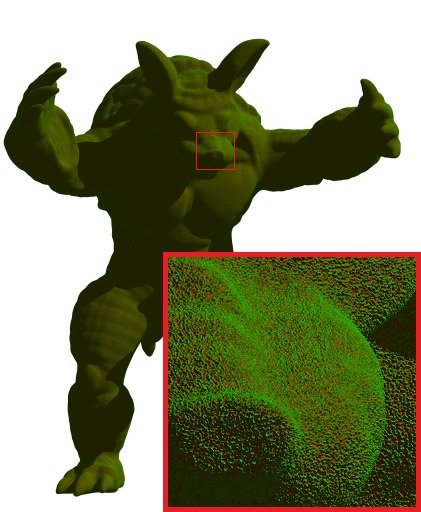Section: New Results
Complex scenes
A Survey of Non-linear Pre-filtering Methods for Efficient and Accurate Surface Shading
Participants : Eric Bruneton, Fabrice Neyret.
Rendering a complex surface accurately and without aliasing requires the evaluation of an integral for each pixel, namely a weighted average of the outgoing radiance over the pixel footprint on the surface. The outgoing radiance is itself given by a local illumination equation as a function of the incident radiance and of the surface properties. Computing all this numerically during rendering can be extremely costly. For efficiency, especially for real-time rendering, it is necessary to use precomputations. When the fine scale surface geometry, reflectance and illumination properties are specified with maps on a coarse mesh (such as color maps, normal maps, horizon maps or shadow maps), a frequently used simple idea is to pre-filter each map linearly and separately. The averaged outgoing radiance, i.e., the average of the values given by the local illumination equation is then estimated by applying this equation to the averaged surface parameters. But this is really not accurate because this equation is non-linear, due to self-occlusions, self-shadowing, non-linear reflectance functions, etc. Some methods use more complex pre-filtering algorithms to cope with these non-linear effects. This paper is a survey of these methods. We start with a general presentation of the problem of pre-filtering complex surfaces. We then present and classify the existing methods according to the approximations they make to tackle this difficult problem. Finally, an analysis of these methods allows us to highlight some generic tools to pre-filter maps used in non-linear functions, and to identify open issues to address the general problem.
Real-time Realistic Rendering and Lighting of Forests
Participants : Eric Bruneton, Fabrice Neyret.
Realistic real-time rendering and lighting of forests is an important aspect for simulators and video games. This is a difficult problem, due to the massive amount of geometry: aerial forest views display millions of trees on a wide range of distances, from the camera to the horizon. Light interactions, whose effects are visible at all scales, are also a problem: sun and sky dome contributions, shadows between trees, inside trees, on the ground, and view-light masking correlations. In this paper we present a method to render very large forest scenes in realtime, with realistic lighting at all scales, and without popping nor aliasing (Figure 15 ). Our method is based on two new forest representations, z-fields and shader-maps, with a seamless transition between them. Our first model builds on light fields and height fields to represent and render the nearest trees individually, accounting for all lighting effects. Our second model is a location, view and light dependent shader mapped on the terrain, accounting for the cumulated subpixel effects. Qualitative comparisons with photos show that our method produces realistic results.
|
Representing Appearance and Pre-filtering Subpixel Data in Sparse Voxel Octrees
Participants : Eric Heitz, Fabrice Neyret.
Sparse Voxel Octrees (SVOs) represent efficiently complex geometry on current GPUs. Despite the fact that LoDs come naturally with octrees, interpolating and filtering SVOs are still issues in current approaches. In this paper, we propose a representation for the appearance of a detailed surface with associated attributes stored within a voxel octree. We store macro- and micro-descriptors of the surface shape and associated attributes in each voxel. We represent the surface macroscopically with a signed distance field and we encode subvoxel microdetails with Gaussian descriptors of the surface and attributes within the voxel. Our voxels form a continuous field interpolated through space and scales, through which we cast conic rays. Within the ray marching steps, we compute the occlusion distribution produced by the macro-surface inside a pixel footprint, we use the microdescriptors to reconstruct light- and view-dependent shading, and we combine fragments in an A-buffer way. Our representation efficiently accounts for various subpixel effects. It can be continuously interpolated and filtered, it is scalable, and it allows for efficient depth-of-field. We illustrate the quality of these various effects by displaying surfaces at different scales, and we show that the timings per pixel are scale-independent (Figure 16 ).




